
Live, from orbit: the Manned Orbiting Laboratory’s top-secret film-readout systemby Dwayne A. Day
|
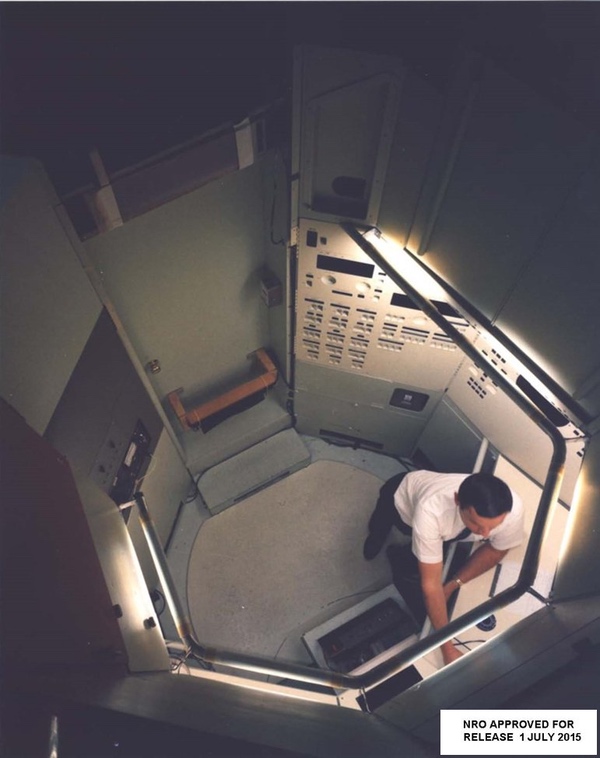 Mockup of the interior of the MOL pressurized compartment where the astronauts would have operated the camera and other systems. Although this was not the final configuration, it shows the limited volume for the astronauts. The film developing and scanning system would have been mounted in here. (credit: NRO) |
The Manned Orbiting Laboratory was started by the Air Force in late 1963, and for most of 1964 and into 1965 the Air Force sought to determine what role military astronauts could play in space. Eventually, along with the National Reconnaissance Office (NRO), they evolved MOL into a reconnaissance satellite carrying a powerful camera system code-named DORIAN. In mid-1965 the program was formally approved by President Lyndon Johnson and the NRO began development, with Air Force support.
| MOL’s 30-day mission was a long time to wait for such expensive photographs, and from the beginning of the program, managers sought methods of returning some of the imagery to Earth before the mission was over. |
MOL/DORIAN would be launched atop a Titan IIIM rocket from Vandenberg Air Force Base in California into a polar orbit. At the top of the payload would be a Gemini capsule carrying two astronauts. Upon reaching orbit, they would leave their Gemini via a long tube and enter the laboratory module. For thirty days they would operate the DORIAN camera system, taking photographs of targets primarily in the Soviet Union.
The photographs would be high-resolution, capable of seeing objects on the ground the size of a baseball. The photographs would provide “technical intelligence,” meaning data on the technical capabilities of weapons systems. Whereas lower resolution satellites could spot missile silos and aircraft on airfields, DORIAN’s photographs would be so good that analysts could determine, for example, the thickness of a missile silo’s walls, or the control surfaces and fuel capacity of a strategic bomber. The downside of this very high resolution was that the camera’s field of view—the area it could see on the ground—was very small. If a target was outside that field of view, it could not be photographed.
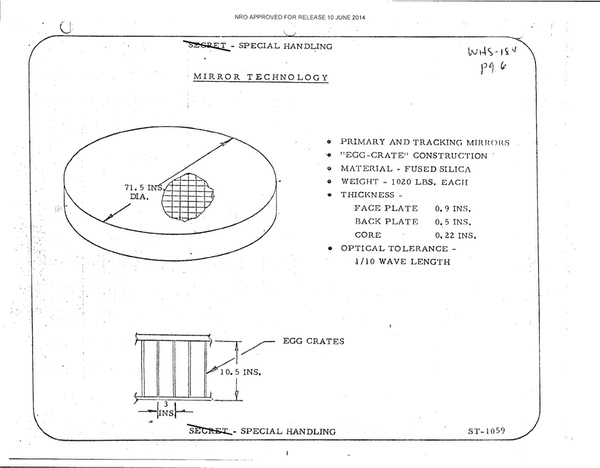 The large primary mirror for the DORIAN optical system in the Manned Orbiting Laboratory was the state of the art at the time. It was very precise and lightweight. It was designed to provide high-resolution images of the ground. (credit: NRO) |
Technical intelligence did not have to be timely intelligence. Analysts determining the range of a ballistic missile could make their assessments over time and did not have to do so immediately. But MOL’s 30-day mission was a long time to wait for such expensive photographs, and from the beginning of the program, managers sought methods of returning some of the imagery to Earth before the mission was over.
The DORIAN camera exposed wide-format film that was located inside the pressurized laboratory module. The astronauts could remove the film from the camera. There were three options for returning the imagery to Earth. The first was to store the film inside the Gemini spacecraft in one of three locations established for that purpose. The amount of film that could be carried in the Gemini was limited by mass, but probably also by volume.
The second option was to place the film in a reentry vehicle that could then be jettisoned and returned to Earth. This “data return vehicle” was based upon the proven design used for the CORONA and GAMBIT reconnaissance satellites. According to one document, designers considered including up to two of these return vehicles in the MOL. The reentry vehicle could carry 27 kilograms (60 pounds) of film, and the Gemini could return 109 kilograms (240 pounds).[1]
The third option was initially proposed in 1964 but was apparently only included in the baseline MOL vehicle later, possibly by early 1966. That involved developing the film in orbit and scanning it using a laser scanning device that converted the light and dark parts of the film into electrical impulses that could then be transmitted via radio to the ground. By March 1966, Eastman-Kodak and General Electric had been contracted to conduct preliminary studies of the performance and the detailed design of a readout system, but program officials concluded that the contractors were not progressing fast enough.[2]
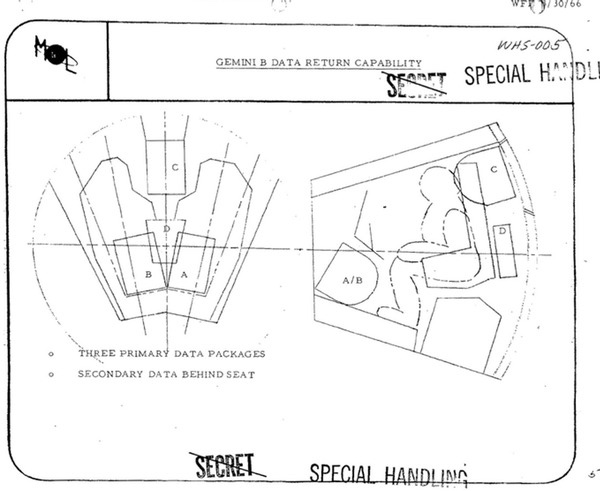 There were three planned methods for returning images to the ground. Storing the exposed film in the Gemini B spacecraft was the primary method. The other options were a small reentry vehicle and the film-readout system. (credit: NRO) |
Film-scanning technology had been developed decades earlier for the newspaper industry to enable photographs to be transmitted over telephone lines, and it had been incorporated into the Air Force’s first reconnaissance satellite, Samos. It was later adapted for use by NASA in the Lunar Orbiter program. Although the available bandwidth limited how many images could be sent to the ground, the MOL astronauts could select only the most important photographs for transmission and the system could be useful for crisis reconnaissance.
Starting around 1965 and continuing through 1966, work had been underway to develop a readout version of the GAMBIT-3 reconnaissance satellite known as FROG. CBS Laboratories was developing a test system to work with the GAMBIT-3 optics. But late in 1966 that work was ordered to be discontinued by February 1967 because the NRO’s Executive Committee concluded that the FROG system was unaffordable and unnecessary considering the other reconnaissance systems in use by the United States. The NRO Director did make the technology available to the Air Force for possible use in reconnaissance aircraft such as the RF-4C Phantom. Although this never transpired, it was used for a ground-based system for scanning and transmitting aerial reconnaissance photos.[3,4]
The CBS Laboratories readout system being developed for FROG, along with plans for the ground processing system, then became part of the baseline for the MOL, replacing the earlier systems being studied by Eastman Kodak and General Electric (see “FROG: The Film Read Out GAMBIT program,” The Space Review, February 7, 2022.)
Both the film-readout system and the film-return system were included in the baseline MOL design, although there was increasing uncertainty about whether both were necessary. In November 1966, an internal NRO evaluation concluded that CBS Laboratories had made considerable progress at developing a readout transmission system. More work remained to be done, but the technology was maturing rapidly.[5]
| Both the film-readout system and the film-return system were included in the baseline MOL design, although there was increasing uncertainty about whether both were necessary. |
The DORIAN camera used film 23 centimeters wide. Each 23-centimeter (9-inch) diameter image on the film had a ground diameter of 2,750 meters (9,000 feet). The readout system was not equipped to transmit an entire frame from the DORIAN camera. Rather, the astronauts would examine the developed film in orbit using a microscope, and then cut out the most important part of the image. This “chip” would then be scanned for transmission to the ground. The system capability was to be up to 160 frame “chips” per day of 5-by-15-centimeter (2-by-6-inch) film-readout, roughly equivalent to 610 by 1,830 meters (2,000 feet by 6,000 feet) on the ground. A 30-day MOL mission could produce up to 5,364 meters of exposed film, although the amount that would be transmitted to the ground would be relatively small.[6]
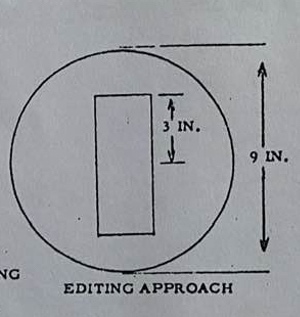 In order to scan the film for transmission of they imagery to the ground, the astronauts would cut out part of a single image. That film "chip" would then be fed through the scanner. (credit: NRO) |
For the surveillance mission the system would provide for target reprogramming, camera performance analysis, and provide time-urgent reconnaissance information. For a technical intelligence mission, it would provide for target reprogramming and camera performance analysis. Compared to the data return vehicle, it could provide daily data return vs. only once or twice for the return vehicle, although it is not clear how much crew time this would require.[7]
One of the requirements for the film-readout system was to transmit the maximum resolution of the photography. Because DORIAN was intended to produce ten-centimeter (four-inch) resolution images, the readout system had to be able to transmit ten-centimeter resolution images. This was necessary for evaluating camera performance.[8]
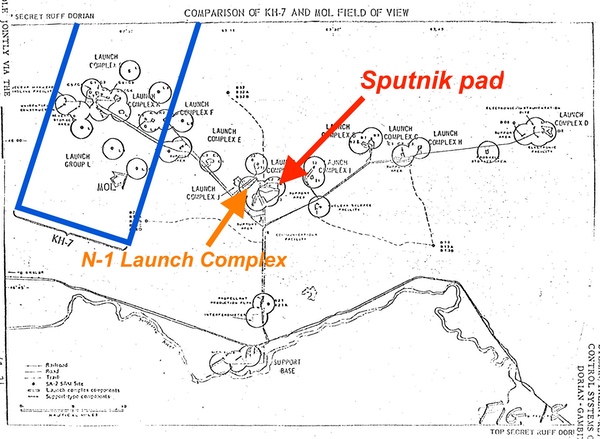 The DORIAN camera system imaged a relatively small area on the ground, about 2,750 meters in diameter. This limited its value for crisis warning, because it could not see events that were spread out over a large territory, such as an invading army. This illustration shows how limited it was for photographing the large Soviet launch facility at Baikonur. (credit: NRO) |
By February 1967, the MOL program came under major budget pressure. After carefully negotiating contracts with multiple contractors, it became clear that the program would not have enough budget to fund them. The MOL program leadership determined that the contract schedules would have to be renegotiated to stay within the available budget line. This also put pressure on management to eliminate systems that were not considered essential to the MOL mission, such as the readout and data return vehicle systems.[9]
In addition, Eastman-Kodak had encountered a problem with the DORIAN system’s fused silica optical components, which due to thermal issues would likely not be capable of achieving the system’s resolution goal for the first two missions. This too may have increased pressure to cancel non-essential equipment.
There were, however, arguments in favor of keeping readout. MOL management was feeling pressure to justify having astronauts on MOL. They realized this as soon as they had been ordered a year earlier to create an unmanned MOL: if the system could operate without astronauts, then why fly astronauts at all? However, the readout system was designed to be operated by astronauts, and there was no way that an automatic MOL could select which images to scan and transmit to the ground or could transmit the massive amount of data in a full-size MOL image.[10]
The MOL program managers increasingly favored the readout system over the data return vehicle. The data return vehicle had a retrorocket and pyrotechnics that posed a risk to the crew, something that became a bigger concern after the January 1967 Apollo 1 fire.
In March 1967, Major General Harry Evans, the deputy director for the MOL program, recommended to the NRO Director that the readout system for MOL be continued and the data recovery capsule be eliminated. Evans argued that the safety and engineering problems of the capsule were serious. He also stated the readout system was superior to the capsule. However, most of his justifications for including the readout system were for engineering testing purposes rather than due to its value as an operational intelligence collection system.[11]
| MOL management was feeling pressure to justify having astronauts on MOL. They realized this as soon as they had been ordered a year earlier to create an unmanned MOL: if the system could operate without astronauts, then why fly astronauts at all? |
On March 20, Colonel Lee Battle wrote a cable to NRO Director Alexander Flax stating that he had decided to cancel the data recovery vehicle and continue the readout system.[12] However, for reasons that are not completely clear based upon available records, Flax did not approve this decision. According to an April 1967 status report, both the readout system and data return vehicle were deleted from the baseline MOL development program.[13] The mass and volume requirements for both systems were still included in the MOL baseline design in the event that the systems were added back to the vehicle.
According to one source, the readout system was canceled in fall 1967, but it may have had sufficient contract funding to carry it a few months beyond April.[14] A General Electric engineer who worked on the reentry vehicle system indicated that it was always on the verge of cancellation, but did not get canceled before the end of the program. It is possible that it also may have continued at a low level of effort using existing funds. Eliminating the reentry vehicle meant that the total film returned would have been limited by the amount that could be carried in the Gemini, even if more could have been carried to orbit.
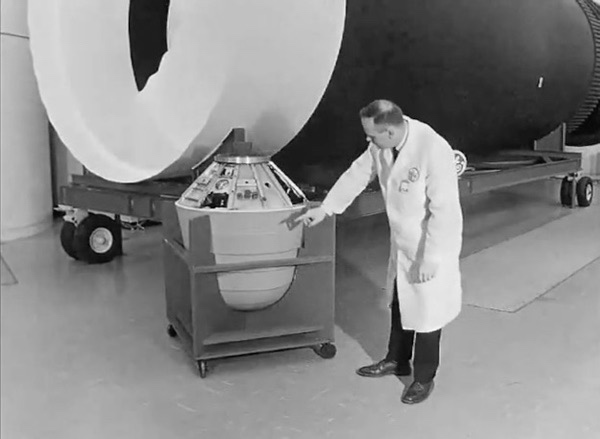 Frame grab from a declassified National Reconnaissance Office video showing a technician pointing to a General Electric reentry vehicle for the Manned Orbiting Laboratory. This reentry vehicle would have been loaded with film by the astronauts on MOL, and returned to Earth sometime before the end of the thirty-day mission. MOL program managers preferred the film-readout system to this "data return vehicle" because this vehicle included pyrotechnics that posed a risk to the astronauts. (credit: NRO) |
In October 1968, General Electric began study of a “poor man’s” wide-band readout system. The new study sought to determine if the data could be relayed through an IDCSP or DCS Phase II communications satellite—the former was already in operation and the latter was scheduled for launch in the early 1970s. Using a relay satellite would dramatically increase the time available to transmit the imagery, from only 500 seconds per day using a single ground station to over 38,000 seconds per day using a satellite in geostationary orbit. More transmission time meant more imagery could be transmitted, although it is unclear how adding this relay capability would have lowered costs.[15]
General Electric provided a report on the capabilities of a readout system by December 1968. The project had often been abbreviated as “R/O” in previous years, and the program decided that in unclassified communications the system would be referred to by the Greek letter “Rho,” although a clever KGB officer might have been able to make the connection.[16]
By May 1969, the plan was to fly four manned MOL vehicles: in July 1972, January and July 1973, and January 1974. If MOL was continued to a Phase II, or Block II configuration, flights could continue on this schedule through January 1976. The Block II MOL could have enhanced capabilities including infrared and multispectral sensors, ultraviolet astronomy, and scene recording and transmission from the tracking scope and the main optics. The mission duration could be extended from the baseline 30 days to 45 days.
| The NRO was undertaking two large imagery satellite development programs at the same time, MOL and an area surveillance satellite named HEXAGON. Both cost roughly the same amount, and national leaders determined that HEXAGON was more valuable, particularly for arms control monitoring. |
One possible upgrade was adding a film-readout capability. The May 1969 report on the Block II vehicle listed several new missions that could be enabled by the availability of readout. These included: crisis management, event warning (including missile tests, launch site or downrange activity, satellite launches, nuclear testing, and ABM site activity), targets of opportunity, and request support.[17] As the report noted, without readout, the mission data was unavailable until the end of the mission, and extending it from 30 days to 45 days increased the delay until people on the ground could see the photographs. For the technical intelligence mission this was not a problem, but for event warning and crisis management, the photographs could be useless by the time they reached the ground.[18]
The communication system for the readout system would require the addition of a 61-centimeter (two-foot) dish that would be deployed from inside the laboratory. It would be located behind a blow-out door and have a boom that would permit viewing the entire hemisphere.
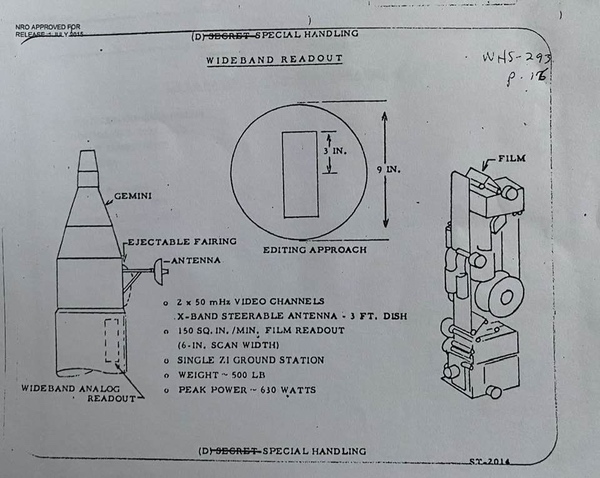 A film-readout system was in development for MOL from approximately 1966-1967 and under study until the MOL program was canceled in June 1969. (credit: NRO) |
MOL was canceled in June 1969 for budgetary reasons. The NRO was undertaking two large imagery satellite development programs at the same time, MOL and an area surveillance satellite named HEXAGON. Both cost roughly the same amount, and national leaders determined that HEXAGON was more valuable, particularly for arms control monitoring, a priority of the new Nixon Administration. HEXAGON could photograph large amounts of territory during every mission at resolution sufficient to identify Soviet weapons systems. MOL was only capable of photographing small amounts of territory, and relatively few targets, at very high resolution. If a primary goal for satellite reconnaissance was counting weapons, then MOL was practically useless, although its technical intelligence capabilities could be useful for assessing weapon performance.
When MOL was canceled, the NRO continued studies of very-high-resolution satellites to fulfill the MOL mission. However, soon the NRO’s interests turned to returning imagery from space on a near-real-time basis, and at a much higher rate and longer duration than MOL’s film-readout system could ever provide. One of the systems considered for this purpose was FROG, which was revived for study in 1970 and briefly approved for active development before finally being rejected in November 1971. Instead, the National Reconnaissance Office began development of the KH-11 KENNEN reconnaissance satellite which used an entirely different approach to sending images down from orbit. Film-readout technology never made it back to space on an American spacecraft.
EndnotesNote: we are using a new commenting system, which may require you to create a new account.